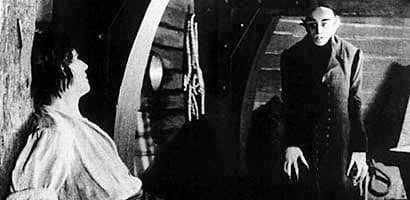Dracula
Critique • Quotes • Text • Dracula at the movies
 First edition
First editionFirst publication
1897
Literature form
Novel
Genres
Literary, fantasy
Writing language
English
Author's country
England
Length
Approx. 180,000 words

Max Shreck, right, is the first memorable Dracula, although he doesn't go by that name.
The evolution of horror icons
Nosferatu the Vampire (1922): Also called Nosferatu: A Symphony of Horror, film, 90 minutes; director F.W. Murnau; writer Henrik Galeen; featuring Max Shreck, Gustav von Wangenheim, Greta Schröder
The cinematic history of Dracula follows a similar pattern to that of Frankenstein. First we get the (mainly forgotten today) films from the silent era. These are followed by the "classic" Hollywood versions, the early black and white movies that established the figures of horror in the popular imagination. Then numerous sequels of varying quality over several decades of the mid-1900s. And later in the century the attempts to rediscover the original stories with serious films going back to the literary sources (though none ever capture the exact spirit of the myth's origins). And the inevitable parodies.
In this way, each generation has created its own interpretation of the most famous vampire myth.
The first known filmic take on the Transylvanian vampire is an Hungarian moving picture, Drakula halála (The Death of Drakula, 1921), of which no copies are known to exist and which, anyway, was reportedly not based on Bram Stoker's novel.
Dracula in all but name
Shortly after this however, the great German film Nosferatu (1922) appeared—and has been studied by film students ever since. Nosferatu was indeed based on the book but without the rights having been bought. Enough names and locales were changed to keep the producers from being sued: it's Count Orlok instead of Dracula, Harkner becomes Hutter, and his fiancée Mina is wife Ellen now.
Paradoxically, the appearance and character of the vampire in Nosferatu is closer to Stoker's conception than any of the approved films that followed.
He's an ugly, selfish creature, played with legendary commitment by Max Shreck. He's just so...different. His unblinking facial movements, his reactions...they just perfectly express a being alien to ourselves. And when he walks the earth in his nightly forays, he seems to be in a trance, moving stiffly with his arms pressed straight down against the sides of his body.
Early scene from the first Dracula movie, the silent film Nosferatu.
I wonder though, does anyone else get the sense he's also the stereotype of an evil Jew, with his outsize hooked nose, bald pate with unruly tufts of sidehair, and his grasping, secretive manner? A Shylock with a love for more than a pound of flesh, sucking the blood of the Aryan middle class? Or is it just knowledge of Germany's tragic history to come that finds anti-Semitism here?
In any case, director F.W. Murnau fashions a creepy expressionist film that's still worth watching if you can get past your reluctance to sit through silent, black-and-white films. It's surprising how many of the scenes seem more alive and real than later silent films and even more so than many of the early talkies.
There's quite a bit of explanatory text in German, and translated by subtitles. Most of the scenes appear to have been shot in daylight (which doesn't make sense for a vampire flick) but versions you are likely to see are tinted, so the night scenes are bluish, and others are in shades of sepia and pink—which is oddly effective.
The making of Nosferatu is also the subject of a more recent fictional film, Shadow of the Vampire (2000).
— Eric
Critique • Quotes • Text • At the movies
1922, 1931, 1936–1945, 1958, 1960–1974, 1979, 1979–1995, 1992, 2000, 2000, 2006

